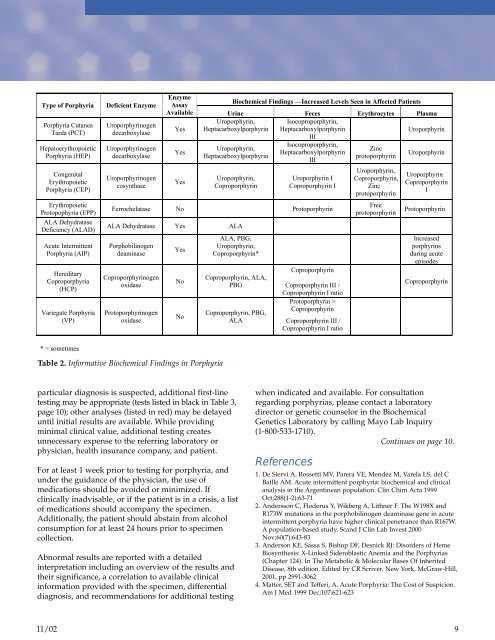The Challenges Of Testing For And Diagnosing Porphyrias
The Challenges Of Testing For And Diagnosing Porphyrias
The Challenges Of Testing For And Diagnosing Porphyrias
You also want an ePaper? Increase the reach of your titles
YUMPU automatically turns print PDFs into web optimized ePapers that Google loves.
Table 2. Informative Biochemical Findings in Porphyria<br />
particular diagnosis is suspected, additional first-line<br />
testing may be appropriate (tests listed in black in Table 3,<br />
page 10); other analyses (listed in red) may be delayed<br />
until initial results are available. While providing<br />
minimal clinical value, additional testing creates<br />
unnecessary expense to the referring laboratory or<br />
physician, health insurance company, and patient.<br />
<strong>For</strong> at least 1 week prior to testing for porphyria, and<br />
under the guidance of the physician, the use of<br />
medications should be avoided or minimized. If<br />
clinically inadvisable, or if the patient is in a crisis, a list<br />
of medications should accompany the specimen.<br />
Additionally, the patient should abstain from alcohol<br />
consumption for at least 24 hours prior to specimen<br />
collection.<br />
Abnormal results are reported with a detailed<br />
interpretation including an overview of the results and<br />
their significance, a correlation to available clinical<br />
information provided with the specimen, differential<br />
diagnosis, and recommendations for additional testing<br />
when indicated and available. <strong>For</strong> consultation<br />
regarding porphyrias, please contact a laboratory<br />
director or genetic counselor in the Biochemical<br />
Genetics Laboratory by calling Mayo Lab Inquiry<br />
(1-800-533-1710).<br />
Continues on page 10.<br />
References<br />
1. De Siervi A, Rossetti MV, Parera VE, Mendez M, Varela LS, del C<br />
Batlle AM. Acute intermittent porphyria: biochemical and clinical<br />
analysis in the Argentinean population. Clin Chim Acta 1999<br />
Oct;288(1-2):63-71<br />
2. <strong>And</strong>ersson C, Floderus Y, Wikberg A, Lithner F. <strong>The</strong> W198X and<br />
R173W mutations in the porphobilinogen deaminase gene in acute<br />
intermittent porphyria have higher clinical penetrance than R167W.<br />
A population-based study. Scand J Clin Lab Invest 2000<br />
Nov;60(7):643-83<br />
3. <strong>And</strong>erson KE, Sassa S, Bishop DF, Desnick RJ: Disorders of Heme<br />
Biosynthesis: X-Linked Sideroblastic Anemia and the <strong>Porphyrias</strong><br />
(Chapter 124). In <strong>The</strong> Metabolic & Molecular Bases <strong>Of</strong> Inherited<br />
Disease, 8th edition. Edited by CR Scriver. New York, McGraw-Hill,<br />
2001, pp 2991-3062<br />
4. Matter, SET and Tefferi, A. Acute Porphyria: <strong>The</strong> Cost of Suspicion.<br />
Am J Med 1999 Dec;107:621-623<br />
11/02 9

















